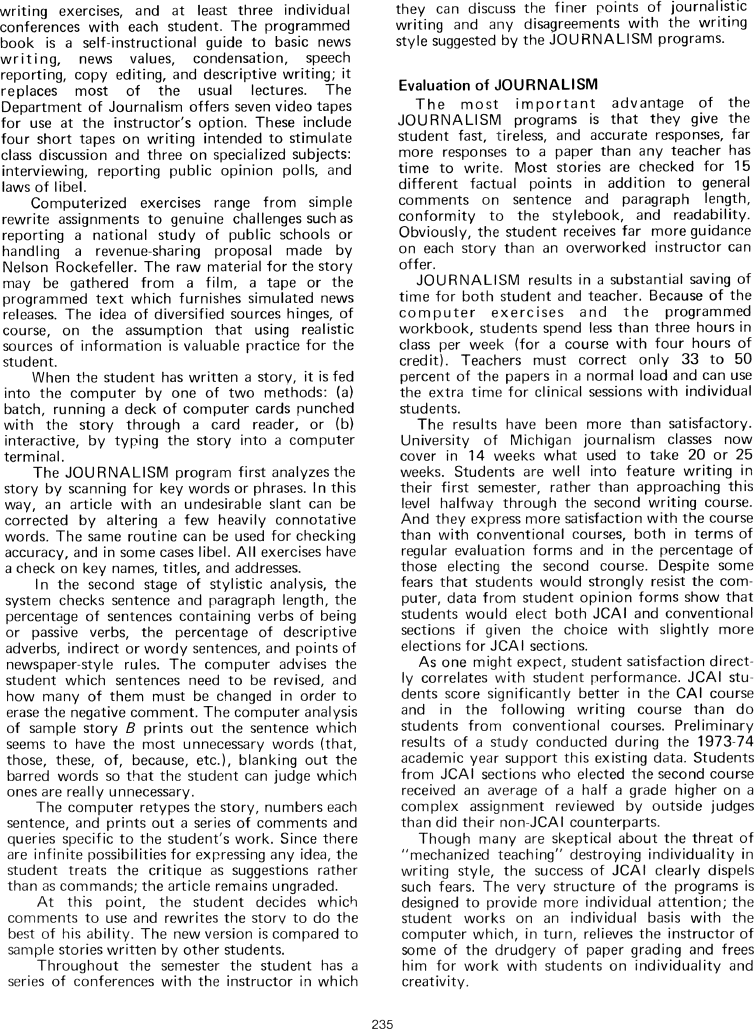The Best of Creative Computing Volume 1 (published 1976)
The JOURNALISM Programs: Help for the Weary Writer (evaluation of JOURNALISM)

writing exercises, and at least three individual
conferences with each student. The programmed
book is a self-instructional guide to basic news
writing, news values, condensation, speech
reporting, copy editing, and descriptive writing; it
replaces most of the usual lectures. The
Department of Journalism offers seven video tapes
for use at the instructor's option. These include
four short tapes on writing intended to stimulate
class discussion and three on specialized subjects:
interviewing, reporting public opinion polls, and
laws of libel.
Computerized exercises range from simple
rewrite assignments to genuine challenges such as
reporting a national study of public schools or
handling a revenue-sharing proposal made by
Nelson Rockefeller. The raw material for the story
may be gathered from a film, a tape or the
programmed text which furnishes simulated news
releases. The idea of diversified sources hinges, of
course, on the assumption that using realistic
sources of information is valuable practice for the
student.
When the student has written a story, it is fed
into the computer by one of two methods: (a)
batch, running a deck of computer cards punched
with the story through a card reader, or (b)
interactive, by typing the story into a computer
terminal.
The JOURNALISM program first analyzes the
story by scanning for key words or phrases. In this
way, an article with an undesirable slant can be
corrected by altering a few heavily connotative
words. The same routine can be used for checking
accuracy, and in some cases libel. All exercises have
a check on key names, titles, and addresses.
In the second stage of stylistic analysis, the
system checks sentence and paragraph length, the
percentage of sentences containing verbs of being
or passive verbs, the percentage of descriptive
adverbs, indirect or wordy sentences, and points of
newspaper-style rules. The computer advises the
student which sentences need to be revised, and
how many of them must be changed in order to
erase the negative comment. The computer analysis
of sample story B prints out the sentence which
seems to have the most unnecessary words (that,
those, these, of, because, etc.), blanking out the
barred words so that the student can judge which
ones are really unnecessary.
The computer retypes the story, numbers each
sentence, and prints out a series of comments and
queries specific to the student's work. Since there
are infinite possibilities for expressing any idea, the
student treats the critique as suggestions rather
than as commands; the article remains ungraded.
At this point, the student decides which
comments to use and rewrites the story to do the
best of his ability. The new version is compared to
sample stories written by other students.
Throughout the semester the student has a
series of conferences with the instructor in which
they can discuss the finer points of journalistic
writing and any disagreements with the writing
style suggested by the JOURNALISM programs.
Evaluation of JOURNALISM
The most important advantage of the
JOURNALISM programs is that they give the
student fast, tireless, and accurate responses, far
more responses to a paper than any teacher has
time to write. Most stories are checked for 15
different factual points in addition to general
comments on sentence and paragraph length,
conformity to the stylebook, and readability.
Obviously, the student receives far more guidance
on each story than an overworked instructor can
offer.
JOURNALISM results in a substantial saving of
time for both student and teacher. Because of the
computer exercises and the programmed
workbook, students spend less than three hours in
class per week (for a course with four hours of
credit). Teachers must correct only 33 to 50
percent of the papers in a normal load and can use
the extra time for clinical sessions with individual
students.
The results have been more than satisfactory.
University of Michigan journalism classes now
cover in 14 weeks what used to take 20 or 25
weeks. Students are well into feature writing in
their first semester, rather than approaching this
level halfway through the second writing course.
And they express more satisfaction with the course
than with conventional courses, both in terms of
regular evaluation forms and in the percentage of
those electing the second course. Despite some
fears that students would strongly resist the computer, data from student
opinion forms show that
students would elect both JCAI and conventional
sections if given the choice with slightly more
elections for JCAI sections.
As one might expect, student satisfaction directly correlates with student
performance. JCAI students score significantly better in the CAI course
and in the following writing course than do
students from conventional courses. Preliminary
results of a study conducted during the 1973-74
academic year support this existing data. Students
from JCAI sections who elected the second course
received an average of a half a grade higher on a
complex assignment reviewed by outside judges
than did their non-JCAI counterparts.
Though many are skeptical about the threat of
"mechanized teaching" destroying individuality in
writing style, the success of JCAI clearly dispels
such fears. The very structure of the programs is
designed to provide more individual attention; the
student works on an individual basis with the
computer which, in turn, relieves the instructor of
some of the drudgery of paper grading and frees
him for work with students on individuality and
creativity.
235


